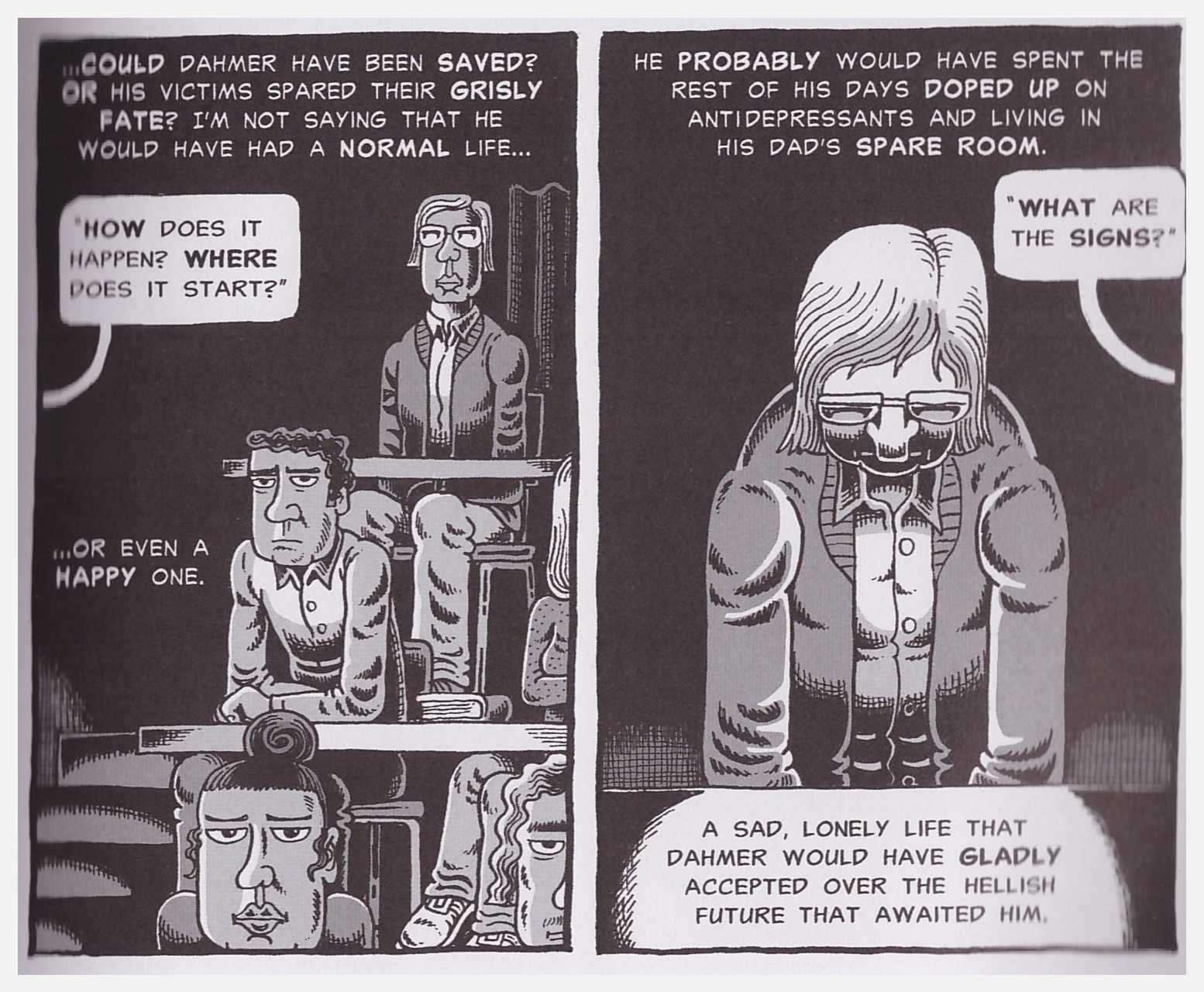Pain and Glory: Great for Spain and Story…
The newest Pedro Almodóvar movie, Pain and Glory, focuses on an aging and debilitated filmmaker, Salvador Mallo (played by Antonio Banderas) reflecting on his life in his old age.


After watching the incredible HBO mini-series, I’ll Be Gone in the Dark, which is a story about the Golden State Killer and Michelle McNamara’s obsession with the case, I started thinking about why I am obsessed with true crime stories. There are many theories about why women in particular have a fascination with true crime, but none that I have personally responded to. To analyze my personal obsession further, I decided to watch 2017’s My Friend Dahmer, a movie adapted from a comic book (which was also adapted into a play) by Derf Backderf. The film follows Jeffrey Dahmer (Ross Lynch) in high school during a brief friendship with John “Derf” Backderf (Alex Wolff) and his group of friends who used Dahmer as a puppet for their own enjoyment. Instead of playing into my true crime interests, it made me consider something else: Why do we care? Why does it matter? Dahmer has interested true crime media since 1991, so what does that say about media representation of killers?
[Spoilers ahead]
Most of us know a little about serial killer Jeffrey Dahmer. As a true crime buff, I know the story front and back. However, I would be curious to know if anyone saw My Friend Dahmer without prior knowledge of his full story (comment if you are that person).
Here is a brief summary, just in case:
Jeffrey Dahmer was a cannibalistic rapist and murderer whose reign of terror lasted from 1978 to 1991 in Milwaukee, Wisconsin (some of Ohio as well). He was arrested and confessed to these crimes, showing little to no remorse, and was murdered by a fellow inmate in 1994.
Dahmer’s Victims:
I want to be sure to acknowledge these men and boys’ names and ages because oftentimes the perpetrator is given all of the attention while the victims are just numbers. Also, note that almost all are men/boys of color.

This brings us to the film. Well, not exactly. My Friend Dahmer covers Jeffrey’s life before his first known crime. We meet Jeffrey in 1974 when he is a freshman in high school and the film ends a few months after he graduates in 1978. Why make a film (or comic book or play) about this time? Perhaps true crime fascination is rooted in the need to know why. Why does someone become a serial killer? In knowing the why, we can work to prevent future Dahmers from society, or at the very least, understand the warning signs. But My Friend Dahmer will not answer the why for us — quite the opposite. Knowing what his future holds, we can see some red flags in his behavior within the film. But none of those red flags are rock-solid indicators.
Option #1: Dahmer is bullied in high school. But the film makes a point to show a classmate being bullied in much more aggressive, hateful ways for being labeled as gay. Dahmer struggles with his sexual identity, so he keeps it well hidden. The tormented classmate does not become a killer, so neither bullying nor homosexuality is a “cause” for his behavior.
Option #2: Dahmer’s parents are a mess. His mother is mentally unstable, and his father is absent and preoccupied. But for the 1970s, his father does a good job of acknowledging his own faults as a parent, even citing his projections onto his son. But Jeffrey is definitely ignored and neglected. Did this cause him to torture and kill? Doubtful. This amount of parental neglect, while harmful and trauma-inducing, is also not rare, and, again, this is the ’70s, so it was even worse at that time.

Option #3: Jeffrey follows his mother’s lead and uses alcohol to cope with his strange inclinations and stress. Were his actions alcohol-induced? Well, if so, there would be a LOT more serial killers in the world.
Option #4: Does Jeffrey just need friends or confidants so he doesn’t feel alone in the hellhole that is high school? Nope. While he is initially used as a clown by Derf and company, there are moments of genuine care and friendship. They tried! But Jeffrey is still spiraling closer and closer to violence.
My Friend Dahmer does not give us an explanation of why Dahmer became Dahmer. It instead reinforces the scariest option that Dahmer himself describes: “I’m just like anyone else.” This is the most terrifying answer possible. Maybe further research and data will show clear indicators of nature versus nurture, so we can all rest easier. If we are using this film as a guide, the scale seems tipped toward a mixture of both nature and nurture, making the understanding of serial killers’ early lives all the more unpredictable.
Through a general mood of dread, this film manages to make the audience feel just enough sympathy for Dahmer without seeing him as a victim of his circumstances. Every character in this film could be in Dazed and Confused or Freaks and Geeks, except Dahmer, making him all the more sinister. He does not belong. No amount of normalcy or friendships or self-awareness seems to sway Dahmer from his horrific path.

Perhaps there are wider explanations for serial killers — why are almost all well-known serial killers men? How does our society not only produce serial killers but also give them enough time and space to claim so many victims? Was Dahmer given the freedom to terrorize for over a decade because his victims were (usually) gay men of color? There is a moment of foreshadowing in the film when Dahmer is paired with the “only black kid at school” on a trip to Washington D.C. He asked this student, “Do your insides look like mine?” It is upsetting to hear, especially knowing what is to come.
So, the question remains, what could we have done to stop him? However, I would ask: Why is society’s inclination to “understand” these White men, while never diving deep to find an explanation behind non-White serial killers, like Lonnie Franklin? Ted Bundy, Joel Rifkin, and Charles Manson are studied, and their early lives are analyzed, while Carl Eugene Watts and Anthony Sowell are just accepted as savage killers, unworthy of critical background research. Why is the killer more rigorously hunted when the victims are White women, while non-binary victims of color are ignored? The combination of a White killer and White female victims will produce movie after movie, television specials and multiple books. A White killer, like Dahmer, is studied because the assumption is that you could prevent a White kid from becoming a killer, and he was able to continuously traumatize so many people because his victims were not White. Dahmer is a fallen angel because he is a White man from the suburbs, and we need to know why he fell. Any non-White killers are easily accepted as monsters, who are not worth any context. If you really want to figure out what makes a killer or really study nature versus nurture in this context, maybe we should try to examine all serial killers, not just the White ones.

My Friend Dahmer is an extremely well-made film, and worth a watch. As Dahmer said in his trial statement, “I know I was sick or evil or both.” I am leaning towards both, Jeff.
(This article was originally published by Sarah Erskine on Medium.)